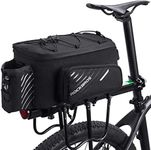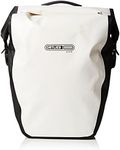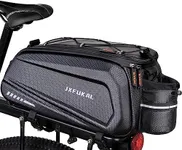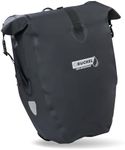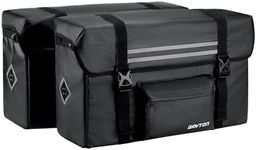Buying Guide for the Best Bicycle Rear Rack Bag
Choosing the right bicycle rear rack bag can greatly enhance your cycling experience, whether you're commuting, touring, or just running errands. The right bag will provide you with the necessary storage space, durability, and ease of use. To make an informed decision, consider the following key specifications and how they align with your needs.CapacityCapacity refers to the amount of storage space the bag offers, usually measured in liters. This is important because it determines how much you can carry. Small bags (5-10 liters) are suitable for light commuting or short trips, medium bags (10-20 liters) are good for daily commuting and moderate loads, while large bags (20+ liters) are ideal for touring or carrying substantial gear. Choose a capacity based on what you typically need to transport.
MaterialThe material of the bag affects its durability, weight, and weather resistance. Common materials include nylon, polyester, and canvas. Nylon and polyester are lightweight and often water-resistant, making them good for all-weather use. Canvas is heavier but very durable. If you ride in various weather conditions, look for water-resistant or waterproof materials to protect your belongings.
Mounting SystemThe mounting system is how the bag attaches to your bike's rear rack. This is crucial for stability and ease of use. Some bags use hook-and-loop straps, which are easy to attach and remove but may not be as secure. Others use clip-on systems that provide a more secure fit but can be more complex to install. Consider how often you'll need to remove the bag and how secure you need it to be.
Compartments and OrganizationCompartments and organization features help keep your items sorted and easily accessible. Some bags have a single large compartment, while others offer multiple pockets and dividers. If you carry a variety of items, such as tools, clothes, and electronics, look for a bag with multiple compartments to keep everything organized. Think about what you typically carry and how you prefer to access your items.
Weather ResistanceWeather resistance refers to the bag's ability to protect your belongings from rain, dust, and other elements. This is important if you ride in varying weather conditions. Some bags are water-resistant, meaning they can handle light rain, while others are fully waterproof and can protect your items in heavy downpours. Consider the typical weather conditions you ride in and choose a bag that offers adequate protection.
Reflective ElementsReflective elements enhance your visibility to others, especially in low-light conditions. This is a key safety feature for cyclists who ride at night or in early morning hours. Look for bags with reflective strips or patches to increase your visibility. If you often ride in low-light conditions, this feature can be very important for your safety.
Ease of AccessEase of access refers to how quickly and conveniently you can get to your items. This is important for efficiency and convenience, especially if you need to access your belongings frequently. Some bags have top-loading designs, while others have side openings or roll-top closures. Consider how often you need to access your items and choose a design that makes it easy for you.
